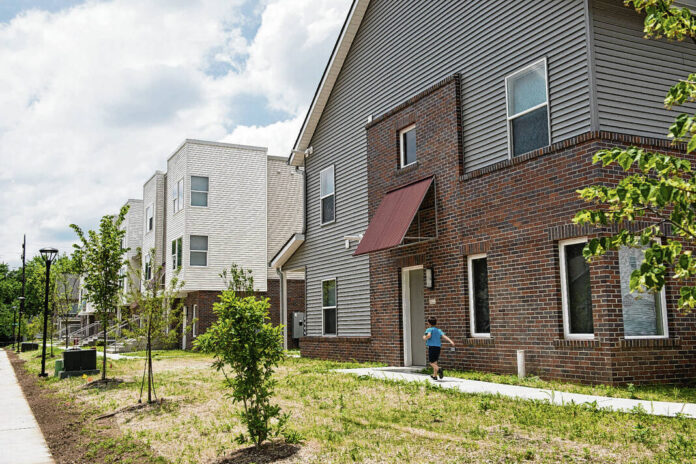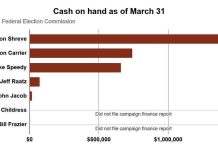
Mike Wolanin | The Republic file photo Damian Gibson, 3, runs to the doorway of his apartment building after the grand opening ceremony for the Gateway Apartment complex in Columbus, Friday, June 17, 2016. Gibson and his mother Brittanie Stott were among the the first residents to move in to the complex.
Most of Bartholomew County’s lowest-income households are feeling the strain of housing costs — including some 1,150 households that are now spending more than half of their paychecks on housing.
That is the conclusion oa new report from advocacy group Prosperity Indiana and the National Low Income Housing Coalition that says Indiana has a shortage of 153,033 affordable housing units for the state’s lowest-income households and that poor Hoosiers now have the worst housing cost burden in the Midwest.
Nearly 3 in 4 of the state’s lowest-income households spend more than half of their income on housing, compared to 3 in 5 in Bartholomew County. That means these households are forced to allocate less of their income to health care, food, day care, recreation, retirement and savings.
In Bartholomew County, there are just 47 affordable units for every 100 renters that make 30% or less of the median income in the area, according to the report, which shows that no county in the state has an adequate supply of affordable housing.
There are even fewer affordable units available in much of the surrounding area, with just 25 available units per 100 renters in Jennings County and 30 units per 100 renters in Jackson County, according to the report.
“There has been a pre-existing housing affordability and stability crisis throughout the state that’s really just been exacerbated throughout the time of the pandemic,” Andrew Bradley, policy director at Prosperity Indiana, told The Republic. “But what really stands out here this year, even compared to previous trends, is that now Indiana has the single highest rate of severe cost burden for extremely low income households among all Midwest states.”
Unprecended hurdles
The numbers, however, do not surprise local officials who say the shortage of affordable housing is a nationwide problem and has existed in Bartholomew County for decades.
But the pandemic has made the problem worse, officials said. Eviction filings in Bartholomew County have been trending higher than the state level since the pandemic hit, with 741 filings from March 15, 2020, to April 9, 2022, according to officials at Prosperity Indiana, citing figures from the Eviction Lab at Princeton University.
At the same time, developers across the country are contending with escalating construction costs, supply chains woes, soaring real estate values and labor shortages, officials said.
City officials have said that affordable housing is a priority. In a previous interview this year, Columbus Mayor Jim Lienhoop said “one of the most important things we can do” is to expand the city’s supply of housing and “make it affordable.”
A total of 395 of the 1,166 housing units built in Columbus over the past decade — 1 in 3 — have been affordable units, meaning that rent is capped at 30% of household income, city officials said. That was up from 25% of all units built over the past 14 years.
Overall, that percentage of households in Bartholomew County that spend at least 30% or more of their paychecks on rent declined from 40% in 2010 to 32% in 2020, though the percentage of the poorest renters in that category increased 5% over the same period, according to U.S. Census Bureau estimates.
Economists generally classify housing as “affordable” when rent is less than 30% of the household’s monthly income. Renters who spend more than that on housing will likely struggle with other expenses.
City officials, for their part, say they are open to any developers who want to build affordable housing in Columbus, but the hurdles that need to be overcome to get projects going have never been steeper.
Currently, there are no proposed affordable housing projects in the pipeline, said Robin Hilber, Columbus assistant director of community development.
“I had one developer who called me, and he’s looking for a place to possibly put an affordable housing unit, but the problem is the cost of the properties have gone up, and between that and the cost of construction … developers are just finding it difficult to be able to build new units,” Hilber said.
“There are just several hurdles right now,” Hilber added. “…We’ve never seen anything like this.”
‘Not getting significantly better’
And some local officials don’t see things getting significantly better in terms of the available affordable housing in the community, pointing to the pandemic, which they say exacerbated the county’s chronic affordable housing shortage.
Not only are they concerned about adding more affordable units in the community, but also what to do when a development’s affordable housing subsidy ends.
Generally, affordable housing developments receive some sort of government subsidy in exchange for agreeing to charge less than market rate for rent for about 15 years, officials said. Though there are ways to extend the subsidies once the period ends, many developers opt to increase rents to market rates.
One apartment complex, Canterbury House Apartments, located near the intersection of Middle Road and Rocky Ford Road, recently informed tenants that its affordable period was ending and would raise rents to market rate, city officials said.
“What concerns me the most is that we’re not really making significant progress in adding additional affordable units in the market,” said Mark Lindenlaub, executive director of Thrive Alliance, a Columbus-based non-profit that provides housing, social and caregiving services in southern Indiana.
“The flip side of that same concern is that we have a number of affordable housing units, especially multifamily apartments, that are coming up on the end of their affordability period,” Lindenlaub added. “…Potentially, we’re not only going to not add a lot of units, but potentially we’ll lose a large number of (affordable) units from the market.”
Thrive Alliance owns about 100 affordable single-family homes in the community, as well as a combined 155 affordable units at the Armory, Gateway Apartments and Cambridge Square Apartments. And occupancy remains at capacity.
“The affordable housing that we own basically stays 100% occupied,” Lindenlaub said. “It’s just an ongoing challenge and ongoing problem for a lot of families.”
“I am not seeing things getting significantly better in terms of the broad sweep of available housing in the community,” Lindenlaub added.
Feeling the strain
However, it’s not just the poorest households that are feeling the strain of housing costs. Estimates from the Census Bureau suggests that the percentage of households in Bartholomew County that make $35,000 to $49,999 and spend at least 30% of their income on rent quadrupled from 2010 to 2020.
In 2010, 8% of Bartholomew County households in that income bracket were spending at least 30% of their income on rent. By 2020, that percentage had jumped to 33%.
Last year, a report by Prosperity Indiana found that a Bartholomew County resident would need to make at least $17.33 per hour to afford a two-bedroom market-rate rental property, or an annual salary of about $36,000.
Census Bureau data suggests that 25% of households in the county made less than $35,000 in 2020.
Michaela Wischmeier, research and communications specialist at Prosperity Indiana and a Columbus resident, said income among lower income brackets hasn’t kept pace with rising housing costs, adding that much of the local focus on attracting and retaining residents has been geared toward middle- and upper-income households.
“Anecdotally, I think we have an intense focus on housing for middle- and upper-class (households),” Wischmeier said. “…We’re leaving a lot of people out who have been in this area for a really long time who are doing their best but still just not able to make it.”
Prosperity Indiana, for its part, is urging state lawmakers to do more and adopt what Bradley described as an “all-of-the-above policy approach” to make up the deficit in affordable housing, including what he said was a “lack of incentives” for developers to build more affordable units.
“Indiana has this reputation of being an affordable place to live with a relatively low cost of living, and frankly, our policymakers lean on that reputation as a reason to not worry about providing a lot of robust services or being proactive when it comes to affordable housing and other community-service policies,” Bradley said.
“Two years into the pandemic and into the response, employers are saying they can’t fill jobs like warehouse workers, like home health care workers, like support personnel in schools, and those are some of the population that we’re talking about where there’s this really severe cost burden and the highest gap in affordable and available housing,” Bradley added.




